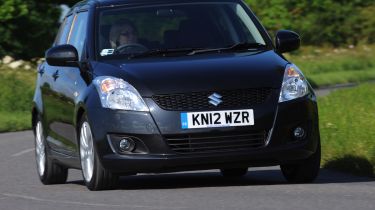Suzuki Swift
Good-value, well equipped and fun-to- drive supermini has plenty going for it
Fun-filled superminis don’t come much better than the current Swift. After only two years on sale, it dominates Suzuki’s line-up, accounting for almost 40 per cent of the company’s sales in the UK.
This success is down to a simple recipe that puts driving thrills and value for money high up the agenda – yet it’s also well built, comfortable and surprisingly refined.
Even though the latest Swift’s styling is a clear evolution from the previous model, it still edges ahead of the i20 for visual appeal. Oversized headlights and chunky bumpers mean it looks tough despite its small size, and while SZ3 models do without front foglights, smart 16-inch alloys are standard. A curving rear screen and wider front grille add to the sporty charm, and this simple-yet-stylish theme continues once you’re inside.
Silver-ringed dials and a pair of supportive front seats instantly make the Swift feel more welcoming than the dreary Hyundai. There are still some scratchy plastics on show, but all the switchgear seems more robust than the i20’s. The thick steering wheel and lovely ball-shaped gearknob both feel as if they come from a far more expensive model. Finding the right driving position is easy and visibility is good, but unlike in the Hyundai, there’s no reach adjustment for the steering wheel.
Used - available now

2021 Suzuki
Swift
20,712 milesManualPetrol1.2L
Cash £11,383
2021 Suzuki
Swift
34,933 milesManualPetrol1.2L
Cash £9,900
2021 Suzuki
Swift
8,233 milesManualPetrol1.2L
Cash £11,200
2019 Suzuki
Swift
16,006 milesManualPetrol1.2L
Cash £10,400Our SZ3 model undercuts the i20 on price, so it’s no surprise to find there’s less kit. While basics like air-con and electric front windows are there, additional creature comforts such as cruise control, Bluetooth and auto lights are reserved for the top-spec SZ4 model (shown in our pictures), which is £830 more, at £12,985.
The Swift’s other major weakness concerns practicality. It’s 145mm shorter than the i20, meaning passengers in the back get slightly less head and legroom, while the Suzuki’s tiny boot almost seems like an afterthought. Its 211-litre capacity is less than that of some city cars – the new VW up! being a prime example – and it’s too high and narrow to carry anything except the smallest bags. This lack of space will rule the Swift out for some buyers, but it soon redeems itself once you hit the road.
The car’s 1.2-litre engine produces only 9bhp more than the Hyundai’s, at 93bhp, but the Suzuki feels more eager at higher revs. It was 1.1 seconds faster from 0-60mph at the track, posting a time of 11.3 seconds, and this extra pace makes it feel nippier in city traffic.
What’s more, the sharp steering, strong brakes and precise gearbox don’t come at the expense of comfort. The Swift soaks up bumps that the i20 thuds over and there’s less noise at speed. This refinement will matter more to most buyers than handling, but like all the best small cars, the Suzuki is huge fun.
It also returned better economy and boasts stronger residuals. Will that be enough to win?
Details
Chart position: 1Why? The Swift is still our default choice in this price range. In SZ3 trim, it’s well equipped and cheap to run, plus fun to drive. But will a smaller boot hold it back?







